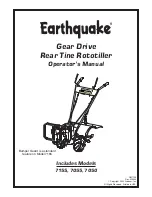
Tilling
Tilling is digging in, turning over and breaking
up garden soil and prepare a seedbed for
planting.
Best tilling depth is 100mm (4”) to 150mm (6”).
A tiller will also clear the soil of unwanted
vegetation.
The decomposition of this vegetation matter
enriches the soil.
Avoid tilling soil that is too dry as it will
pulverize and produce a dust that will not hold
water. Water a few days before tilling. Also,
tilling soil that is too wet will produce
unsatisfactory clods. Wait a day or two after
heavy rain for the soil to dry.
Better growth will be obtained if an area is tilled
properly and used soon after tilling to preserve
the moisture content.
The type of soil and working conditions will
determine the actual setting of the tilling depth.
In some soils, the desired depth is reached first
pass over garden. In other soils, the desired
depth is obtained by going over the garden two
or three times. In later case, the depth
regulator rod should be lowered before each
succeeding pass over the garden. Passes
should be made across the length and width of
the garden alternately. Do not try to dig too
deeply in the first pass. If the machine jumps or
bucks, allow the unit to move forward at
a lightly faster rate.
If the tiller stops forward motion and tries to dig
in one spot, rock the handles from side to side
to start it moving forward again.
Rocks which are turned up should be removed
from the garden area.
Cultivating
Cultivating is loosening or digging around
growing plants to disrupt weeds and aerate
soil. Less than 50mm (2”) depth is always
desirable.
Содержание GMTBT50HP55BS
Страница 21: ...SCHEMA DES PIECES ...
Страница 42: ...LIJST VAN ONDERDELEN ...
Страница 61: ...TROUBLE SHOOTING ...
Страница 62: ...PARTS SCHEDULE ...






































